Radishrain
Things pertaining to life: plants and animals, gardening, cooking, food, botany, zoology, farming, ranching, wildlife, genetics, plant breeding, software, media, etc.
So, I was thinking today that pill bugs have a lot of legs. I figured they must not be insects. So, I looked them up to find out what they were, and Wikipedia says they're crustaceans. Then I found the following article:
https://www.thoughtco.com/fascinating-facts-about-pillbugs-4165294
It's very interesting, and I recommend reading it, but it has a few myths and/or partial myths in it.
Myth #1: Pill bugs aren't pests. Actually, pill bugs are sometimes pests (but please don't use pesticides on them). They sometimes (but rarely) chew on mature pepper, horseradish and potato foliage, and fairly commonly on seedlings of various species and such. They sometimes (but rarely) burrow holes in ripe tomatoes. They're not usually a threat to mature plants, whether or not they eat parts of them (pretty much just young ones). Nevertheless, it's a prevelant myth that it's a myth that pillbugs are pests. It is true that they perform beneficial actions, but gardeners do get distressed about their behavior at times. In my observation, they're more of an issue when the pillbugs are numerous and the plants are few. To deal with pillbugs, I just pick the ones I can find up at transplanting time and throw them somewhere else, and I remove the uncomposted organic matter that attracts them. I also overseed and wait a while after transplanting to thin the plants. Pillbugs don't usually bother plants (as often) after they're established, or if there's a big group of plants. Some people argue that the plants or fruits afflicted with pill bigs were rotting or would have died anyway, but I don't think this is always the case. They do target tender plants, however. Tougher plants shouldn't be bothered.
Myth #2: Pillbugs prefer humid environments. Well, this is and it isn't a myth. Pillbugs can live in semi-arid areas just fine, but they prefer to live under things where it's moist and dark. They like moisture (it's not a humidity thing, necessarily). While it's possible that they do indeed prefer to live in humid environments, they proliferate in climates where it's not humid, too.
Myth #3: Pillbugs can't survive in areas where it gets -20° F. or lower. My area gets that cold and colder (although not every year, certainly), and we still have loads of pillbugs.
Myth #4: Pillbugs aren't burrowers. Well, I don't know that they burrow holes to live in and stuff, but they're certainly capable of burrowing extremely well (better than most other burrowers, in fact). If you try burrying some in my garden, they'll dig their way out pretty fast, even if they're a fair ways down. Sometimes I incidentally burry them when I'm transplanting, and they burrow up out of the dirt. It's amazing, in fact. I think I've found them under the soil of their own accord, too, but I'll have to watch and verify that.
I'm skeptical about them dying when they're more than 30% dry. Ours seem to be able to handle more dryness than that. They can handle a lot more dryness than slugs and snails.
It's possible that our pillbugs are a special species adapted to drought, burrowing, cold, and being pests. There are lots of species of pillbugs, and I imagine each species is different.
I'm curious how they taste now that I've learned they're crustaceans. Our toads eat them quite a bit, it seems. You never know when an animal has parasites or diseases you could catch, though, especially when humans don't usually eat it.
https://www.thoughtco.com/fascinating-facts-about-pillbugs-4165294
It's very interesting, and I recommend reading it, but it has a few myths and/or partial myths in it.
Myth #1: Pill bugs aren't pests. Actually, pill bugs are sometimes pests (but please don't use pesticides on them). They sometimes (but rarely) chew on mature pepper, horseradish and potato foliage, and fairly commonly on seedlings of various species and such. They sometimes (but rarely) burrow holes in ripe tomatoes. They're not usually a threat to mature plants, whether or not they eat parts of them (pretty much just young ones). Nevertheless, it's a prevelant myth that it's a myth that pillbugs are pests. It is true that they perform beneficial actions, but gardeners do get distressed about their behavior at times. In my observation, they're more of an issue when the pillbugs are numerous and the plants are few. To deal with pillbugs, I just pick the ones I can find up at transplanting time and throw them somewhere else, and I remove the uncomposted organic matter that attracts them. I also overseed and wait a while after transplanting to thin the plants. Pillbugs don't usually bother plants (as often) after they're established, or if there's a big group of plants. Some people argue that the plants or fruits afflicted with pill bigs were rotting or would have died anyway, but I don't think this is always the case. They do target tender plants, however. Tougher plants shouldn't be bothered.
Myth #2: Pillbugs prefer humid environments. Well, this is and it isn't a myth. Pillbugs can live in semi-arid areas just fine, but they prefer to live under things where it's moist and dark. They like moisture (it's not a humidity thing, necessarily). While it's possible that they do indeed prefer to live in humid environments, they proliferate in climates where it's not humid, too.
Myth #3: Pillbugs can't survive in areas where it gets -20° F. or lower. My area gets that cold and colder (although not every year, certainly), and we still have loads of pillbugs.
Myth #4: Pillbugs aren't burrowers. Well, I don't know that they burrow holes to live in and stuff, but they're certainly capable of burrowing extremely well (better than most other burrowers, in fact). If you try burrying some in my garden, they'll dig their way out pretty fast, even if they're a fair ways down. Sometimes I incidentally burry them when I'm transplanting, and they burrow up out of the dirt. It's amazing, in fact. I think I've found them under the soil of their own accord, too, but I'll have to watch and verify that.
I'm skeptical about them dying when they're more than 30% dry. Ours seem to be able to handle more dryness than that. They can handle a lot more dryness than slugs and snails.
It's possible that our pillbugs are a special species adapted to drought, burrowing, cold, and being pests. There are lots of species of pillbugs, and I imagine each species is different.
I'm curious how they taste now that I've learned they're crustaceans. Our toads eat them quite a bit, it seems. You never know when an animal has parasites or diseases you could catch, though, especially when humans don't usually eat it.
Take a look at what QAGUY of TomatoJunction is doing to make tomato cages and cucumber trellises out of PVC pipe: https://www.tomatojunction.com/viewtopic.phpf=26t=1101
Although that's the real link (for post #19310), it doesn't work going to it from external sites for some unknown reason. 😒 Go to TomatoJunction.com, go to The Gallery, and look for a thread called QAGuys Garden (Wed May 06, 2020 3:14 pm). I think you'll have to register and login to see the pictures, too.
Basically, there are vertical poles in the middle of each of four horizontal poles (the are linked for foam a square), which vertical poles anchor it to the ground, and allow for the same thing to be placed on top to extend it when needed.
Anyway, now I want to get a bunch of PVC pipe. Those short cages look perfect for muskmelons in my garden (without any additions). In the case of my muskmelons, I like a short cage to increase productivity—not to reduce the space the plant takes up (although doing that is fine, too, if the fruits don't slip when ripe). It doesn't take much of a lift to seem to increase production quite a bit. Each horizontal pole is broken into two parts (in order to attach the vertical poles going down perpendicular to them).
You could take these cages apart at the end of the season, too, I imagine.
tomato_
tomato_cage
cucumber_
cucumber_trellis
cage_
support_
trellis_
Although that's the real link (for post #19310), it doesn't work going to it from external sites for some unknown reason. 😒 Go to TomatoJunction.com, go to The Gallery, and look for a thread called QAGuys Garden (Wed May 06, 2020 3:14 pm). I think you'll have to register and login to see the pictures, too.
Basically, there are vertical poles in the middle of each of four horizontal poles (the are linked for foam a square), which vertical poles anchor it to the ground, and allow for the same thing to be placed on top to extend it when needed.
Anyway, now I want to get a bunch of PVC pipe. Those short cages look perfect for muskmelons in my garden (without any additions). In the case of my muskmelons, I like a short cage to increase productivity—not to reduce the space the plant takes up (although doing that is fine, too, if the fruits don't slip when ripe). It doesn't take much of a lift to seem to increase production quite a bit. Each horizontal pole is broken into two parts (in order to attach the vertical poles going down perpendicular to them).
You could take these cages apart at the end of the season, too, I imagine.
tomato_
tomato_cage
cucumber_
cucumber_trellis
cage_
support_
trellis_
Horseradish flowers look very nice! The plants, too.
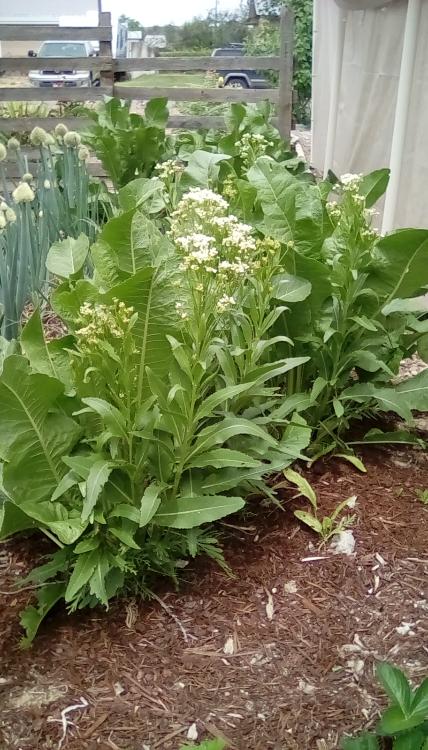
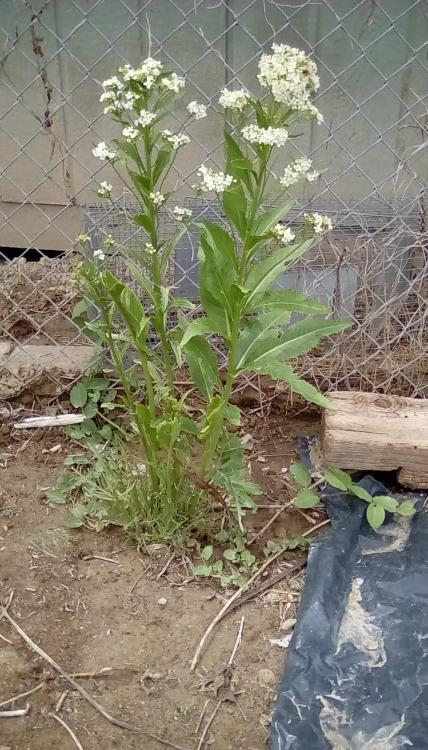
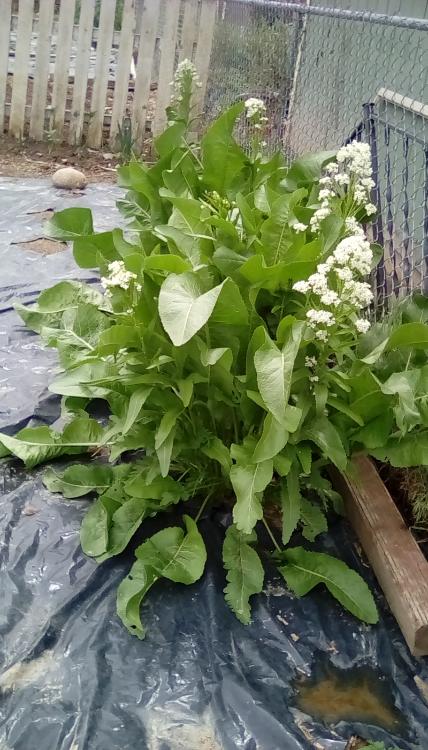



Did this flower make an appearance in the movie Frozen by chance?
We've got some in the backyard. It looks pretty nice (the flowers are a much brighter white than the picture depicts):
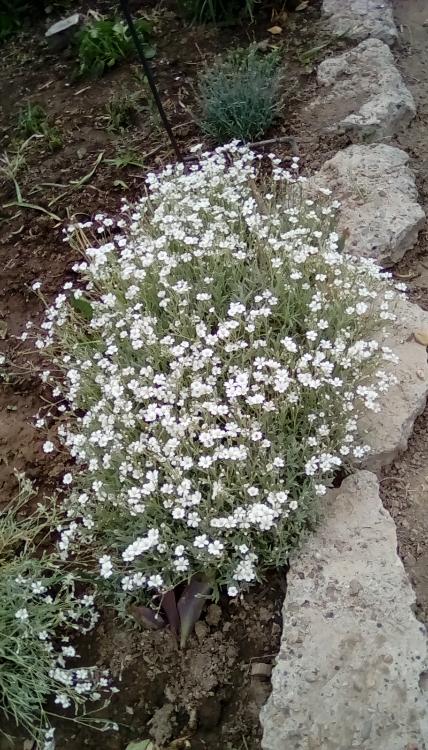
We've got some in the backyard. It looks pretty nice (the flowers are a much brighter white than the picture depicts):

Here are my plants, so far, this year. They've been up for a little while now. the cotyledons have been getting bigger, however.
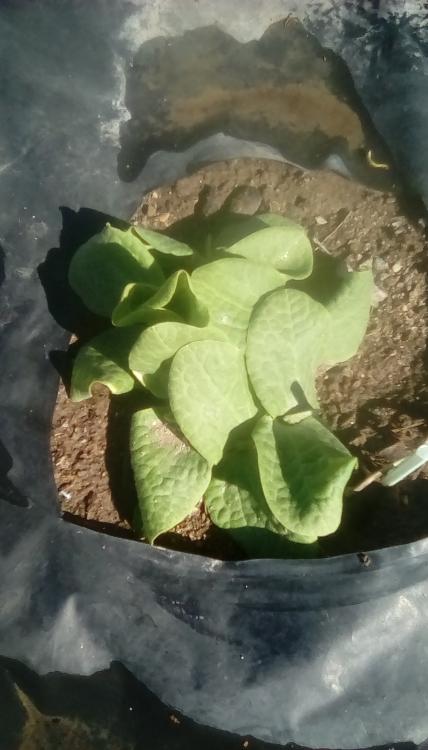

I've decided to pre-start various kinds of seeds, including some that I haven't had success starting in containers and/or direct-seeded.
I've germination-tested Galapagos Island tomato seeds this way before (in the winter or so), but this is my first time doing it to plant them afterward. I've also planted viviparous Cushaw White squash seeds (meaning, they sprouted roots inside the squash). I direct-seeded some and put others in foam cups with soil in them. The ones in the cups sprouted. A large percentage (but not all, so far; they still have time) of the ones in the ground sprouted.
Anyway, I'm trying it with the following kinds of plants:
* Burpee Tenderpod beans
* Kentucky Wonder beans
* Rattlesnake pole beans
* Lovage
* Job's Tears
* Blue Doll F2 squash (old)
* Zucchini (old)
* Yomogi
* Winter savory
* Crimson Cushion tomato
* Zi Su shiso
* Mammoth Sandwich Island salsify
and maybe other stuff.
Anyway, here's my method (which is essentially the paper towel method using empty paper herbal tea bags instead of paper towels):
1. Take an empty herbal tea bag, a snack-sized zipper bag, and a marker.
2. Put a few to several seeds in the bag (ideally spread out)
3. Put the herbal tea bag with seeds in the zipper bag.
4. Add a little water to the zipper bag (get the herbal tea bag and seeds wet).
5. Drain out excess water if there's a lot.
6. Zip up the zipper bag.
7. Label the bag with the marker.
8. Put the bag somewhere warm, and wait for the seeds to sprout roots (add more water as needed if necessary).
Then, when the roots are the desired size, direct-seed them wherever.
I've germination-tested Galapagos Island tomato seeds this way before (in the winter or so), but this is my first time doing it to plant them afterward. I've also planted viviparous Cushaw White squash seeds (meaning, they sprouted roots inside the squash). I direct-seeded some and put others in foam cups with soil in them. The ones in the cups sprouted. A large percentage (but not all, so far; they still have time) of the ones in the ground sprouted.
Anyway, I'm trying it with the following kinds of plants:
* Burpee Tenderpod beans
* Kentucky Wonder beans
* Rattlesnake pole beans
* Lovage
* Job's Tears
* Blue Doll F2 squash (old)
* Zucchini (old)
* Yomogi
* Winter savory
* Crimson Cushion tomato
* Zi Su shiso
* Mammoth Sandwich Island salsify
and maybe other stuff.
Anyway, here's my method (which is essentially the paper towel method using empty paper herbal tea bags instead of paper towels):
1. Take an empty herbal tea bag, a snack-sized zipper bag, and a marker.
2. Put a few to several seeds in the bag (ideally spread out)
3. Put the herbal tea bag with seeds in the zipper bag.
4. Add a little water to the zipper bag (get the herbal tea bag and seeds wet).
5. Drain out excess water if there's a lot.
6. Zip up the zipper bag.
7. Label the bag with the marker.
8. Put the bag somewhere warm, and wait for the seeds to sprout roots (add more water as needed if necessary).
Then, when the roots are the desired size, direct-seed them wherever.
https://scitechdaily.com/vitamin-d-determines-severity-in-covid-19-researchers-urge-government-to-change-advice/amp/
If the whole world read this article, there might be a vitamin D supplement shortage.
vitamin_d
If the whole world read this article, there might be a vitamin D supplement shortage.
vitamin_d
I've found that blending up sunroots with tomato sauces and/or soups makes them pretty tasty! Additionally, it helps to thicken them and add nutrients.
You can make an excellent ketchup and cocktail sauce substitute by doing this:
• Blend up a jar of home-canned stewed tomatoes (skins, seeds, juice, and all, if you like; they all turn into sauce).
• Blend several whole sunroots into them. (If you bake the sunroots well before blending them, it adds an additional pitentially desirable flavor.)
• Add distilled white vinegar and salt (as you would with ketchup).
Then it's ready! Four ingredients. That's it. I find that I use more of it with my food than I use ketchup.
By itself, it's unique, although an excellent dipping sauce, similar to ketchup and cocktail sauce (you probably want more salt and vinegar to get a steonger cocktail-type flavor). If you add mustard to it, it tastes just like ketchup with mustard in it, except it has an earthy aftertaste (which I personally like).
Adding sunroots to tomato soup adds a substance to the flavor, similar probably to what broth does to tomato soup.
I imagine all kinds of recipes could utilize sunroots to make a large variety of awesome new sauces.
Sunroots (including both raw and baked sunroots) blend up very easily in a blender with stewed tomatoes.
I've tested this with spring-harvested sunroots, so far. These seem to be firmer when cooked, sweeter (a lot like carrots), and have less inulin than fall-harvested sunroots. They taste like a mix between potatoes and carrots. The fall ones seem to taste more like a mix between already salted and buttered baked potatoes, steamed cauliflower, and seafood; I haven't tried those in sauce, yet.
Anyway, I've tried the sauce with mustard with hamurgers (I dipped them instead of spreading it on). I tried it without mustard with meatloaf patties (which patties included tomatoes, but no ketchup), and it was excellent!
tomato_
salt_
vinegar_
sauce_
ketchup_
soup_
recipe_
tomato_soup
broth_
stewed_tomato
canned_tomato
You can make an excellent ketchup and cocktail sauce substitute by doing this:
• Blend up a jar of home-canned stewed tomatoes (skins, seeds, juice, and all, if you like; they all turn into sauce).
• Blend several whole sunroots into them. (If you bake the sunroots well before blending them, it adds an additional pitentially desirable flavor.)
• Add distilled white vinegar and salt (as you would with ketchup).
Then it's ready! Four ingredients. That's it. I find that I use more of it with my food than I use ketchup.
By itself, it's unique, although an excellent dipping sauce, similar to ketchup and cocktail sauce (you probably want more salt and vinegar to get a steonger cocktail-type flavor). If you add mustard to it, it tastes just like ketchup with mustard in it, except it has an earthy aftertaste (which I personally like).
Adding sunroots to tomato soup adds a substance to the flavor, similar probably to what broth does to tomato soup.
I imagine all kinds of recipes could utilize sunroots to make a large variety of awesome new sauces.
Sunroots (including both raw and baked sunroots) blend up very easily in a blender with stewed tomatoes.
I've tested this with spring-harvested sunroots, so far. These seem to be firmer when cooked, sweeter (a lot like carrots), and have less inulin than fall-harvested sunroots. They taste like a mix between potatoes and carrots. The fall ones seem to taste more like a mix between already salted and buttered baked potatoes, steamed cauliflower, and seafood; I haven't tried those in sauce, yet.
Anyway, I've tried the sauce with mustard with hamurgers (I dipped them instead of spreading it on). I tried it without mustard with meatloaf patties (which patties included tomatoes, but no ketchup), and it was excellent!
tomato_
salt_
vinegar_
sauce_
ketchup_
soup_
recipe_
tomato_soup
broth_
stewed_tomato
canned_tomato
https://bonnieplants.com/gardening/you-must-use-a-good-potting-mix/
They probably know what they're doing since they sell plants that can be pretty vigorous. So, I looked them up to see what's likely in the potting mix of the plants they sell.
Basically, they say about what I'd expect, with a few important extras added in. It looks like decent advice.
-----
I might note that avoiding garden soil in containers (including for seed-starting), as they said, is a popular exhortation, but it's not necessarily bad (and I've never seen a potting mix that includes soil). Whether a person might want to use garden soil really depends on what they're doing, what results they want, how they're doing it, why they're doing it, and where they're doing it. But yeah, keep regular garden soil outdoors, please! It can spread hard-to-erradicate pests and diseases indoors.
In my Strong Camel 6'x5'x3' unheated greenhouse, I like to use regular garden soil for starting muskmelons, watermelons, and squash in 8oz foam cups. They do need to be watered on time to ensure that the soil doesn't shrink, stifle the roots, and compact too much, however, and it's best to overseed if you use it, it seems (more plants mean more roots breaking up the soil, which means better aeration, and better germination should it be difficult). I'm sure BonniePlants' ideal mix would be at least as effective, if not a lot better, however, without requiring as many seeds (but regular garden soil is pretty much free, and it does work better than many unideal soil-free mixes in this context; plus, you generally don't need to add extra fertilizer or minerals to regular soil after the plant gets a little bigger).
If I were to use any regular garden soil in smaller containers, in my unheated greenhouse, I wouldn't bring those indoors, and I would only mix a small amount of it with my seed-starting mix (like 1 to 10% or less), and I would mostly only use it for the purpose of adding extra nutrients/bacteria (and to reduce fertilization needs); also, I'd use it to help acclimatize the plants for transplanting (into regular garden soil) faster. I haven't historically used regular garden soil in my seed starting mixes for cells, though. So, if I try it, I might have other things to say about it.
vegetable_
soil_
potting_mix
They probably know what they're doing since they sell plants that can be pretty vigorous. So, I looked them up to see what's likely in the potting mix of the plants they sell.
Basically, they say about what I'd expect, with a few important extras added in. It looks like decent advice.
-----
I might note that avoiding garden soil in containers (including for seed-starting), as they said, is a popular exhortation, but it's not necessarily bad (and I've never seen a potting mix that includes soil). Whether a person might want to use garden soil really depends on what they're doing, what results they want, how they're doing it, why they're doing it, and where they're doing it. But yeah, keep regular garden soil outdoors, please! It can spread hard-to-erradicate pests and diseases indoors.
In my Strong Camel 6'x5'x3' unheated greenhouse, I like to use regular garden soil for starting muskmelons, watermelons, and squash in 8oz foam cups. They do need to be watered on time to ensure that the soil doesn't shrink, stifle the roots, and compact too much, however, and it's best to overseed if you use it, it seems (more plants mean more roots breaking up the soil, which means better aeration, and better germination should it be difficult). I'm sure BonniePlants' ideal mix would be at least as effective, if not a lot better, however, without requiring as many seeds (but regular garden soil is pretty much free, and it does work better than many unideal soil-free mixes in this context; plus, you generally don't need to add extra fertilizer or minerals to regular soil after the plant gets a little bigger).
If I were to use any regular garden soil in smaller containers, in my unheated greenhouse, I wouldn't bring those indoors, and I would only mix a small amount of it with my seed-starting mix (like 1 to 10% or less), and I would mostly only use it for the purpose of adding extra nutrients/bacteria (and to reduce fertilization needs); also, I'd use it to help acclimatize the plants for transplanting (into regular garden soil) faster. I haven't historically used regular garden soil in my seed starting mixes for cells, though. So, if I try it, I might have other things to say about it.
vegetable_
soil_
potting_mix
Subscribe via email
Archives
| Free forum by Nabble | Edit this page |


